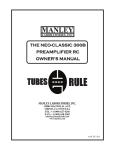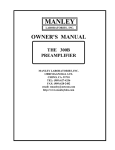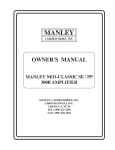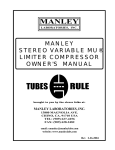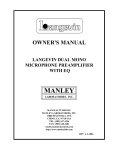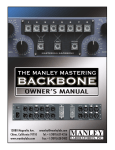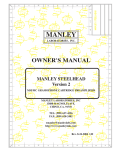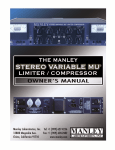Download Manley SE/PP 300B Owner`s manual
Transcript
MANLEY LABORATORIES, INC. THE NEO-CLASSIC 300B PREAMPLIFIER OWNER'S MANUAL TUBES RULE brought to you by the clever folks at: MANLEY LABORATORIES, INC. 13880 MAGNOLIA AVE. CHINO, CA. 91710 USA TEL: (909) 627-4256 FAX: (909) 628-2482 www.manleylabs.com Rev. 10/08 CONTENTS SECTION PAGE INTRODUCTION & GENERAL NOTES 3 MAINS CONNECTIONS 4 CONNECTING YOUR PREAMPLIFIER 5 FIGURE 1 FRONT PANEL 6 FIGURE 2 TOP VIEW 7 FIGURE 3 BACK PANEL 8 OPERATIONAL NOTES 9 SPECIFICATIONS 10 WARRANTY 11 WARRANTY REGISTRATION 12 2 INTRODUCTION THANK YOU!... for choosing the Manley Laboratories "The 300B Preamplifier". Handcrafted in Chino, CA, the Neo-Classic 300B Preamplifier uses beautiful sounding parts in a clever and clean signal path. This Preamp features the 300B direct heated triode as the line and headphone driver. The 300B is typically used in low power amplifiers as a power tube. These 300B-based amps generally deliver 5 to 9 watts single-ended and cost from $3,000 to over $100,000! Some of these amps sound very nice coupled with efficient speakers. Our Neo-Classic 300B SE/PP Power Amplifier uses a pair of 300B’s that can be operated single-ended or push-pull, and delivers up to 22 watts. We consider the 300B to be an extremely luscious tube for low-power purposes. Driving headphones and cables is a natural application for these tubes. This is where the impedances are not too low and the power requirements are not too high but where smaller triodes tubes might run out of steam. In our Neo-Classic 300B Preamplifier, we combine the classic 300B with another classic - the octal-based 6SL7GT dual triode to perform the amplification duties. To complement this tube choice we also employ tube-based rectification and regulation as well as our usual extreme filtering with gobs of large filter caps. To complement our best sounding line driver to date, we surround it with proven passive compnoents such as gold plated connectors, high purity copper wire, Mil-spec printed circuit boards with extra thick copper and plating, ceramic sockets, and custom-designed transformers. All the audiophile goodies are in here and together the sum total is a beautiful sounding preamplifier which we know will provide years of faithful service. LOCATION & VENTILATION The Neo-Classic 300B Preamplifier must be installed in a stable location with ample ventilation. It is recommended, if this unit is rack mounted, that you allow enough clearance on the bottom of the preamp such that a constant flow of air can flow through the ventilation slots. The top should be given enough clearence to allow sufficient ventilation above the tubes. We also recommend that the preamplifier be placed at least 10 inches away from its amplifier. WATER & MOISTURE As with all electronic equipment, this unit should be kept away from moisture of any kind. You’re allowed to weep with joy at the sounds it makes, but keep those salty tears away from the power supply! SERVICING The user should not attempt to service the preamplifier beyond that described in the owner’s manual. Refer all servicing other than tube replacement to Manley Laboratories. SPECIAL NOTES The 300B’s are packaged separately to prevent damage. You will need to carefully plug them in before powering-up the preamp. Pay attention to the size of the pins to properly align the tubes before inserting. The large pins go into the large sockets. It is difficult but possible to insert the 300B’s wrong and damage the preamp. Tubes may become loose during transit. Straighten and press down each tube before plugging the preamplifier into the mains socket. Furthermore, do not touch the tubes while the preamplifier is switched on, as the tubes do become very hot during operation and should only be handled after the power has been turned off and the tubes have cooled. Please read over this entertaining and enjoyable owner s manual carefully as it contains information essential to the proper operation and maximum enjoyment of this instrument. Thank you again, and please enjoy your new Neo-Classic 300B Preamplifier! (and the clever Owner s Manual.) UNPACKING: Unpack the preamplifier carefully and make sure that all supplied accessories are present. Carefully examine all items for any possibility of shipping damage. All the tubes should show no signs of distress such as chipped glass, loose internal components or obvious breakage. If the preamplifier is damaged or fails to operate, notify the shipper or your dealer or us or your local authorities immediately. Or if you suspect The Shipping People threw it off the airplane and onto your front porch whilst flying overhead at 30,000 feet, notify the shipping company without delay and complain to them as we only guarantee this unit to be able to survive a drop of 23,487 feet or less. Your Neo-Classic 300B Preamplifier was packed with extreme love and includes the following components and accessories: a) 1 each, 6 foot IEC 3-conductor power cable (that you will probably replace with an expensive audiophile cord anyway.) b) 1 each, Owner s Manual (that we hope you will keep reading.) c) The tubes: 2 x 300B, 2 x 6SL7GT, 2 x OD3, and 2 x 5U4 vacuum tubes It is prudent to retain the shipping materials for future use, as they are custom-formed for the preamp and will greatly minimize the chance of shipping-related damage should you ever need to put your precious Neo-Classic 300B Preamplifier in the careless hands of The Shipping People again. 3 MAINS CONNECTIONS Your Manley Neo-Classic 300B Preamplifier has been factory set to the correct mains voltage for your country. (Well, that is what we intended to do when we knew where it would be initially shipped.) The mains voltage that we built this Manley Neo-Classic 300B Preamplifier to operate with is marked on the serial badge, located on the rear panel. Check that this complies with what comes out of your wall. There is no voltage changeover switch! There are jumpers on the power transformer PCB that are soldered to put the transformer primaries in parallel for 117v operation or into series for 230/240v countries so be sure to check the sticker and the serial number voltage indication for proper mains voltage. Failure to properly comply with mains voltage requirements can cause extensive damage to the system, which of course would not be covered by the warranty. If you relocate from, say, a 120v country to a 240v country, you will need to change power transformer jumpers or use a step-up outboard converting transformer. The mains fuse may be checked by first disconnecting the IEC mains cord from the power supply’s power inlet plug. Then gently push and rotate counterclockwise the fuseholder retainer cap. The fuse and cap should spring outward toward your fingers. Inspect the fuse for the proper rating; change if necessary. Refer to the fuse rating chart in the specifications section of this manual. If you do not know what a blown fuse looks like, you may measure for continuity across the fuse ends. If your meter reads “OL” when you measure across the fuse, that means “Open Leads” and that would mean the fuse is blown. A blown fuse usually indicates A Very Bad Thing occurred. If this has happened to you, try to figure out why it may have happened. (Using a Fast Blow fuse when we have specified a SLO-BLO fuse is one reason...) If you have no idea why a fuse might have just blown on its own, you might want to consult with Manley Labs or your dealer for further advice as something Very Bad might have occured, like the power transformer might have decided to retire early. One way this could happen is by running the wrong mains voltage into the unit. Be sure not to do that. If you live in a strange place... Export units for certain markets have a moulded mains plug fitted to comply with local requirements. If your unit does not have a plug fitted the coloured wires should be connected to the appropriate plug terminals in accordance with the following code. GREEN/YELLOW EARTH terminal BLUE NEUTRAL terminal BROWN LIVE terminal As the colours of the wires in the mains lead may not correspond with the coloured marking identifying the terminals in your plug proceed as follows; The wire which is coloured GREEN/YELLOW must be connected to the terminal in the plug which is marked by the letter E or by the safety earth symbol or coloured GREEN or GREEN and YELLOW. The wire which is coloured BLUE must be connected to the terminal in the plug which is marked by the letter N or coloured BLACK. The wire which is coloured BROWN must be connected to the terminal in the plug which is marked by the letter L or coloured RED. DO NOT CONNECT OR SWITCH ON THE MAINS SUPPLY UNTIL ALL OTHER CONNECTIONS HAVE BEEN MADE. (...or else...) 4 CONNECTING YOUR PREAMPLIFIER Setting up your preamplifier is rather easy. 1. Please refer to page 8 for an illustration of the back of the preamplifier. 2. Connect the RCA outputs to the input of your power amplifiers when they are off. 3. UNBALANCED inputs are found on RCA jack inputs and can be connected to any line level sources such as CD players, tuners or tape decks. 4. All RCA jacks are clearly labeled as to a typical function. Each input is, for all intents and purposes, functionally and electronically the same. Only the labels are different. 5. The record output is not buffered and it is recommended that one have the tape feed plugged into the REC OUT only when actually recording. Care should be used when using a 3-head tape/monitor switch as this record out is not a tape loop. 6. On the left end of the back panel is a standard IEC mains connector. This should be connected to a standard mains outlet with the supplied cable. This unit has been hardwired for the mains voltage in your country 7. Power up the preamplifier FIRST and allow it to settle for a minimum of 30 seconds before powering up your amplifiers. Turn off your preamplifier and source components LAST when powering down a system. This prevents amplification of turn-on transients and other noises when powering up or turning a system off and ultimately protects the speakers. 5 FRONT PANEL HEADPHONES VOLUME OFF ON AUX TAPE CD TUNER VIDEO A B C D E F A - INPUT SELECT - 5 Position switch for input selection. Each input is electrically identical. The RECORD OUT directly follows this switch. There is no buffer amp to isolate the effects of loading and cable capacitance so we recommend disconnecting any interconnect cables from the RECORD OUT if you are not recording. B & C - HEADPHONE JACKS - Standard 1/4" stereo headphone jacks. The HEADPHONE IMPEDANCE SWITCH (on top of the unit) should be set for the range that best matches your headphones. The maximum power output primarily depends on the actual headphone impedance. Typically the preamp can deliver 1 watt (10 volts RMS ) into 100 ohms and 1 watt (25 volts RMS) into 600 ohms. These outputs are transformer coupled for highest possible isolation from shock hazards, cable shorts, and other potential problems. D - VOLUME - Audiophile-grade Noble pot. E - BACKLIT PANEL - This is the power indicator. When it is lit-up, your unit is on. When it is not lit-up, your unit is off. F - POWER SWITCH - Self explanatory. Because tubes require some time to warm up there is about 10 seconds of silence followed by "not-so-good sound" before "wow". The best way to power up the system is sources ( CD, turntable, etc) first, then this preamp, then after a 30 second wait - turn on the amplifiers. Wait a minute or so - then play tunes. This allows everything to warm up. Some people hear a difference after an hour or two but it depends on the equipment. Powering down is the opposite order - power amps first. This procedure is a good habit to follow because it stresses the speakers and ears the least. The power supply in this preamp is tube based which has the inherant advantage of slow start (as the tubes warm up). This gives the least stress to the internal components. 6 TOP VIEW OD3 5AR4 or 5U4G OD3 5AR4 or 5U4G A 300B 300B B C 6SL7GT 6SL7GT A - HEADPHONE IMPEDANCE SWITCH - You should set this switch to best match your headphones. You may have to look at the specification sheet to get the value in ohms. If using two sets of phones divide that number in 2. If you don't have this info then pick the setting that sounds best - no harm will be done. If the phones are lower than the switch setting, slight loss of extreme highs may occur. Expect the 300 ohm - 4000 ohm setting to be louder. Electronically, we are simply either using the two transformer output windings in series or parallel. B - TRANSFORMER SWITCH - Switchable between "Direct" and "Transformer". Make sure to switch to "Transformer" when using headphones. C - OUTPUT SWITCH - Switchable between "Line Output" (out to your amplifier) and "Headphone" (which mutes the Line Out, as you are presumably listening with headphones and don't need your speakers). TUBE LOCATIONS - See the diagram above for the proper tube locations. The 300B's are not installed during shipping to prevent damage to these tubes. Power should be unplugged and the tubes cool before handling them. We label the tubes and sockets to help and so that the calibration we do will be valid in your home. It is possible to put the 300B's in wrong. Note the two large pins and the two small pins on the base of the tube. The two large pins go into the two large holes in each tube socket. CALIBRATION: Each channel is factory-set for 12 dB of voltage gain (1V in = 3.2V out ) via a pair of trimpots located on the main printed circuit board near the headphone jacks. These pots adjust the amount of negative feedback in order to exactly match the gain between both channels. Only 8.5dB of Global Negative Feedback is used which can be considered minimal. Unless you hear a channel-tochannel imbalance after say, changing tubes, you probably do not have to re-trim the levels. There is no other adjustment that needs to be made. There is no bias to have to set. 7 REAR PANEL F C D E A B G J H I A - MAINS FUSE - Depending on your local power outlet's voltage, replace with 3A SLOBLO fuse (120 V) or 1.5A SLO-BLO fuse (230V). B - IEC MAINS SOCKET - Standard IEC mains socket (120/240 VAC as indicated) C - MAIN OUTPUT - Main left and right outputs driven by 300B's. Connect these to your power amplifier inputs when the amps are off. D - SUBWOOFER OUTPUT - Same as Main Output. E - RECORD OUTPUT - Set at input line stage level. These normally are connected to a tape recorder's inputs. The signal is "picked off" the input selector and before the volume control. It is a good idea to disconnect any wires connected to these jacks when not recording to prevent extra loading and cable capacitance from affecting the best possible performance. F - TUNER INPUT - Connect your tuner outputs here. G - AUX INPUT - This is where you plug your Aux in - no, not your cattle. "Aux" stands for Auxilliary and basically means "extra", so this is just an extra input for any other source that we didn't label or you have two of. Any of the input jacks can be used with any Hi-Fi RCA outputs, as they are electrically identical and only differ in how we labeled them. H - VIDEO INPUT - Audio actually, from a DVD, Laserdisk, TV, VHS, or BetaMax (or, um, whatever's current...) player's audio output. I - CD INPUT - Plug in your audio outputs from your CD player or D/A Converter here. J - TAPE INPUT - Tape machine outputs can be connected here. Be very careful - If the tape machine inputs are connected to the preamplifier's RECORD OUTs and the preamp is switched to TAPE and the tape machine is set to monitor "INPUT" or you start to record - beware the dreaded squeal and howl of feedback! One quick "cure" is to not select "TAPE" on the rotary input selector if these other conditions are met. 8 OPERATIONAL NOTES SWITCHING ON The power knob is located on the right hand side of the front panel. Turn the knob to the right to turn on the preamp, or to the left to turn it off. Don't ever rock it back and forth rapidly. Note: on this knob and on the input selector there is a long garolite 1/4" rod shaft that connects the faceplate knob to the actual switch in the back of the unit. If the knob starts spinning round and round then the little screws on the shaft-to-switch coupler have come loose. If this happens to you, UNPLUG the power from the unit, remove the bottom cover, and tighten the 4 x coupler screws with a 1/6" hex key. No biggie. RUNNING It is not recommended that you leave your preamplifier permanently switched on. This only wastes electricity and tube life. Your preamplifier has both tube and solid state rectification and reaches peak operating condition in approximately 30 minutes. Also, running is good for your muscular and cardiovascular health. TUBE LIFE As with all tubes, their quality degrades with age. This is due to cathode emission, a natural process found in all tubes. We recommend that you have your preamplifier checked every 4-5 years, depending on usage. An excessive increase in noise level can indicate the need to replace the 6SL7 input tubes. 300B's usually last a very very long time.. HEADPHONES Select the proper impedence for your headphones with the switch located on the top of the preamp. Remember, when listening with headphones you MUST have the "Transformer" output selected, not the "Direct" out. Headphones like the transformers a lot. REPLACING A TUBE? Gently wiggle the tube while pulling it out of the socket. Before putting a new tube in, look at it. Check to see that the pins are straight. Locate the "key" on the tube's center locating pin and line that up to the key in the socket. You should be able to gently push the tube into the socket without excessive force. You can wiggle it in a little bit as you push down. HUM? This unit is meant to use the third pin of the mains as the ground reference. Many power amps also use the third pin mains ground. Here we have a potential source of hum caused by ground loops. Usually a hifi system will want to see the mains ground at only one place. Which piece of gear should be grounded will have to be determined by experimentation using 3 pin to 2 pin "cheater" adapters on your power cords. Sometimes one power amp will be grounded and all other gear will have adapters. Sometimes the better option is to ground the preamp and "float" the amps. You will have to find out what works best in your system. Another source of hum can come from equipment stacked on top of one another. Stacking gear too closely can restrict airflow causing premature componentry failure and it is likely to introduce hum, buzz or noise into the system. Some equipment can radiate strong magnetic fields outside of its chassis and other gear may be prone to receiving the hum or buzz these fields can cause. You can move units away from each other to hear if increased distance will solve a hum or buzz issue. 9 SPECIFICATIONS * * * * * * * * * * * * * * * * * * * * * * * * * * * * * * * * Inputs: 5 stereo pair unbalanced RCA jacks Outputs: 2 stereo pairs MAIN out same as SUB out unbalanced RCA jacks RECORD output: 1 stereo pair pre-volume control unbalanced RCA jacks HEADPHONE Outs: 2 front panel 1/4" headphone jacks Optimized headphone impedance switching: 30-400 ohms to 300-4000 ohms MUTE: Selecting HEADPHONE operation mutes LlNE outputs Output Vacuum Tubes: 2 x 300B Electro-Harmonix Input Tubes: 2 x 6SL7GT Electro-Harmonix Rectifier Tubes: 2 x 5U4GBEH Electro-Harmonix or 5AR4 China (Do NOT use the Sovtek 5AR4!) Regulator Tubes: 2 x OD3 NOS JAN USA Gain: factory set at 12 dB at max Volume Internal Variable Feedback: 8.5 dB of global NFB is used @ 12 dB of gain, adjustable trim -1.7dB to +1dB Noise Floor: typically -70 dB (1 Hz - 100 KHz) S/N Ratio: typically 105 dB (A WGT, 20 Hz - 20 KHz) Frequency Response: 5 Hz to 50 KHz ±1dB Channel-to-Channel Separation (L to R): @1KHz 48 dB; @10KHz 35 dB; @20KHz 34 dB Channel-to-Channel Separation (R to L): @1KHz 50 dB; @10KHz 40 dB; @20KHz 37 dB THD: 0.08 % @ 1KHz at 1V rms out Distortion THD+N: -80 dB (.01 %) zero "crossover" distortion, mostly 2nd harmonic Input Sensitivity: 250mV (-9.8dBu) yields 1V out Input Impedance: 100 Kohm Noble volume control Maximum Input Level: 5.5dBu or 1.459 Vrms @ 1KHz, volume control at maximum Output Impedance (LINE STAGE): 100 ohms Maximum Output Level: 17.2dBu or 5.636 Vrms @ 1KHz, volume control at maximum Output Power (100 ohm Headphones): 1W (10 V RMS) (28 V P-P) Output Power (600 ohm Headphones): 1W( 25 V RMS) (70 V P-P) Power Consumption: 170 Watts (1.4 A @ 120VAC) Operating Mains Voltage: Factory set for 100V, 120V or 220-240VAC operation for original destination country's mains voltage. Operating Mains Voltage: changeable with power transformer re-wiring and fuse value change. Mains Voltage Frequency: 50~ 60Hz Dimensions: W=19". L=13". H=3 1/2" Shipping Weight: 28 Ibs. 10 WARRANTY Manley Laboratories, Inc. WARRANTY STATEMENT effective 10/2008 All Manley and Langevin branded equipment designed and built by Manley Laboratories, Inc. is covered by a limited warranty against defects in materials and workmanship for a period of 90 days from date the unit is sold to the Dealer to the original purchaser only. A further optional limited 5 year transferable warranty is available upon proper registration of ownership within 30 days of date of first purchase. This warranty cannot be transferred outside of the USA in the case of secondhand purchases which are consequently exported. Proper registration is made by filling out and returning to the factory the warranty card attached to this general warranty statement, along with a copy of the original sales receipt as proof of the original date of purchase, or registration can be made online in the Tech Support section of www.manleylabs.com. This warranty is provided by the dealer where the unit was purchased, and by Manley Laboratories, Inc. Major subassemblies that were not built by Manley Laboratories, Inc. specifically the SLAM! ADC/DAC/SRC digital board designed and built by Anagram Technologies, SA of Switzerland will be warranted to the same terms the supplier warrants the subassembly to Manley Laboratories, Inc. Under the terms of the warranty defective parts will be repaired or replaced without charge, excepting the cost of consumables such as vacuum tubes and lamps. Vacuum tubes and meter or badge lamps are warranted for six months provided the warranty registration is completed as outlined above. If a Manley Laboratories, Inc. product fails to meet the above warranty, then the purchaser's sole remedy shall be to first obtain a Repair Authorisation from Manley Service Department and return the product to the Manley Service Center, where the defect will be repaired without charge for parts and labour. All returns to Manley Laboratories, Inc. or the Manley Service Center must be in the original packing, accompanied by the Repair Authorisation, and must be shipped to the address specified on the Return Authorisation via insured freight at the customer's own expense. Factory original packaging can be ordered from Manley Laboratories, Inc. Customer will be charged for new factory original packaging if customer fails to ship product to Manley in the original factory packaging. After repair, the product will then be returned to customer via prepaid, insured freight, method and carrier to be determined solely by Manley Laboratories, Inc. Manley Laboratories, Inc. will not pay for express or overnight freight service nor will Manley Laboratories, Inc. pay for shipments to locations outside the USA. Charges for unauthorized service and transportation costs are not reimbursable under this warranty, and all warrantees, express or implied, become null and void where the product has been damaged by misuse, accident,neglect, modification, tampering or unauthorized alteration by anyone other than Manley Laboratories, Inc. If a unit is received for warranty repair, and after complete examination and testing no problem is found with the unit, customer will be charged for one hour of labor plus return shipping costs, presuming initial user error falsely caused the unit to be determined faulty. The warrantor assumes no liability for property damage or any other incidental or consequential damage whatsoever which may result from failure of this product. Consequential component damage resulting from vacuum tube failure in specific is not covered by warranty. Any and all warrantees of merchantability and fitness implied by law are limited to the duration of the expressed warranty. All warrantees apply only to Manley Laboratories, Inc. products purchased and used in the USA. All warrantees apply only to Manley Laboratories, Inc. products originally purchased from an authorised Manley or Langevin dealer. Manley Product that was not purchased through an authorised and legitimate sales channel is considered "Grey Market". Warranties for Manley Products purchased outside the USA will be covered by the Manley Importer for that specific country or region. Product originally sold to the USA market and consequently resold overseas forfeits its warranty. American Manley Dealers are expressly forbidden to export Manley Product. "Grey Market" purchases are not covered by any warranty. In the case that a Manley Product must be returned to the factory from outside the USA, customer shall adhere to specific shipping, customs, and commercial invoicing instructions given with the Return Authorisation as Manley Laboratories, Inc. will not be responsible for transportation costs or customs fees related to any importation or re-exportation charges whatsoever. Some states do not allow limitations on how long an implied warranty lasts, so the above limitations may not apply to you. Some states do not allow the exclusion or limitation of incidental or consequential damages, so the above exclusion may not apply to you. This warranty gives you specific legal rights and you may also have other rights which vary from state to state. For Tech Support and Repair Authorisation, please contact: Manley Laboratories, Inc. Tech Support and Service 13880 Magnolia Ave. Chino, CA. 91710 Tel: +1 (909) 627-4256 x325 Fax: +1 (909) 628-2482 11 WARRANTY REGISTRATION We ask, grovel and beg that you please fill out this registration form and send the bottom half to: MANLEY LABORATORIES REGISTRATION DEPARTMENT 13880 MAGNOLIA AVE. CHINO CA, 91710 USA Or you may FAX this form in to: +1 (909) 628-2482 or you may fill in the online warranty registration form found in the Tech Support section of our website www.manleylabs.com or you can be really diligent and register your warranty three times to see if we get confused! Registration entitles you to product support, full warranty benefits, and notice of product enhancements and upgrades, even though it doesn't necessarily mean that you will get them (Just kidding!) You MUST complete and return the following to validate your warranty and registration. Thank you again for choosing Manley gear and reading all the way through The Owner's Manual. (We really mean that sincerely, the bit about thanking you for choosing our gear. THANK YOU!!!) MODEL NEO-CLASSIC 300B PREAMP SERIAL #__________________ PURCHASE DATE ______________ SUPPLIER ______________________ -------------------------------------------------------------------------------------------------------PLEASE DETACH THIS PORTION AND SEND IT TO MANLEY LABORATORIES MODEL NEO-CLASSIC 300B PREAMP SERIAL #__________________ PURCHASE DATE ______________ SUPPLIER ______________________ NAME OF OWNER _______________________________________________ ADDRESS ______________________________________________________ CITY, STATE, ZIP ________________________________________________ EMAIL: ________________________________________________________ TELEPHONE NUMBER___________________________________________ COMMENTS OR SUGGESTIONS?__________________________________ ________________________________________________________________ 12












